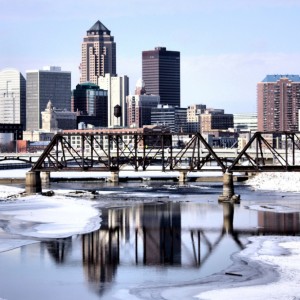Federal Water Tap, March 9: Water Is Prominent in Spy Agency’s Worldwide Threat Assessment
The Rundown
Water remains on the security agenda. Infrastructure spending drops. Mexico takes steps to address its Rio Grande water deficit. Two water studies, on sewer infrastructure and tribal water use, will be delayed. Tribal water rights agreement signed. U.S.-China water-energy partnership looks for research collaborators.
“Several trends are converging that will probably increase the frequency of shocks to human security in 2015. Emerging infectious diseases and deficiencies in international state preparedness to address them remain a threat, exemplified by the epidemic spread of the Ebola virus in West Africa. Extremes in weather combined with public policies that affect food and water supplies will probably exacerbate humanitarian crises. Many states and international institutions will look to the United States in 2015 for leadership to address human security issues, particularly environment and global health, as well as those caused by poor or abusive governance.” — Office of the Director of National Intelligence report on global threats in 2015.
By the Numbers
10 percent: federal share of U.S. water infrastructure spending in 2014 (Congressional Budget Office)
$US 14.4 billion: federal dollars spent on water infrastructure in 2014, compared to $US 125 billion from state and local government (Congressional Budget Office)
275,000 acre-feet: Mexico’s water deficit in the Rio Grande Basin to the United States at the end of 2014 (U.S. State Department)
Reports and Studies
Infrastructure Spending Down
Local, state, and federal spending on transportation and water infrastructure fell 9 percent between a 2003 peak and 2014 when accounting for inflation for construction-related materials, according to the Congressional Budget Office.
Some 90 percent of spending on water treatment plants, distribution pipes, dams, and levees in 2014 came from local and state governments, the report reckons. The federal share peaked in the 1970s, after passage of the Clean Water Act, at between 15 percent and 20 percent of total spending.
Mexico’s Rio Grande Water Deficit
The U.S. State Department, according to a report submitted to Congress, is working with Mexican counterparts to bring Mexico into compliance with a treaty that allocates the waters of the Rio Grande, the river that forms the Texas-Mexico border. At the end of 2014, Mexico was 275,000 acre-feet behind schedule, or roughly nine months of its annual water-delivery obligation.
News Briefs
Worldwide Threats
Water again holds a prominent place in the Director of National Intelligence’s annual worldwide threat assessment.
“Extreme weather, climate change, and public policies that affect food and water supplies will probably create or exacerbate humanitarian crises and instability risks,” the report states. Water shortages that affect food production and energy development will pose the greatest challenge for the Middle East, North Africa, and South Asia because those regions also have growing populations and stagnant economies, according to the report.
The report also highlights the strategic importance of shared river basins, which can be a source of conflict when an upstream country decides to build a dam or divert water without basinwide consent, as is currently the case in the Nile, Mekong, and Indus watersheds.
Colorado River Tribes Study Delayed
A report on current tribal water use and future demand in the Colorado River Basin will be not be published until mid-2016, according to Carly Jerla of the Bureau of Reclamation, who is helping to lead the study. The report was supposed to be published in December 2015.
Tribal Water Rights Settlement
Interior Secretary Sally Jewell signed a $US 60 million water rights settlement with the Shoshone-Paiute Tribes of Nevada. The money, which is authorized by the settlement but still needs to be allocated by Congress, will go toward irrigation improvements, infrastructure to deliver municipal water and sewer services, or restoring rivers. The agreement is the sixth Indian water rights settlement that the Obama administration has completed since 2009.
On the Radar
EPA Clean Water Needs Survey
Both Republicans and Democrats on the Senate Environment and Public Works Committee criticized the U.S. Environmental Protection Agency for being late in reporting the nation’s sewer infrastructure needs.
Every four years the agency is required to submit a report to Congress assessing the money needed to achieve the goals of the Clean Water Act. The agency still has not completed the 2012 report. EPA spokesman Robert Daguillard told Circle of Blue that he did not know the expected publication date.
U.S.-China Water-Energy
The U.S. Department of Energy opened a $US 12.5 million competition for a water-energy research partnership that was a part of the November climate deal between the two countries. Funding for the partnership, which will study water used in energy production, will total $US 50 million over five years, split evenly between the two governments and two research partners.
Federal Water Tap is a weekly digest spotting trends in U.S. government water policy. To get more water news, follow Circle of Blue on Twitter and sign up for our newsletter.
Brett writes about agriculture, energy, infrastructure, and the politics and economics of water in the United States. He also writes the Federal Water Tap, Circle of Blue’s weekly digest of U.S. government water news. He is the winner of two Society of Environmental Journalists reporting awards, one of the top honors in American environmental journalism: first place for explanatory reporting for a series on septic system pollution in the United States(2016) and third place for beat reporting in a small market (2014). He received the Sierra Club’s Distinguished Service Award in 2018. Brett lives in Seattle, where he hikes the mountains and bakes pies. Contact Brett Walton





Leave a Reply
Want to join the discussion?Feel free to contribute!